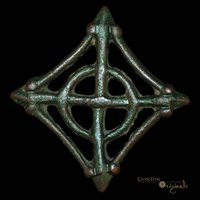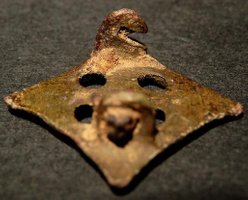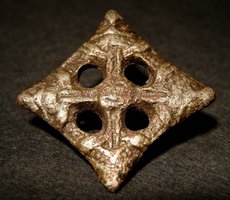Viking lozenge brooch with an interlaced circle.
A mysterious lozenge brooch, a question unanswered and a equally rare lozenge brooch type also found in England..
This week I'd like to tell some more about a specific type of Viking Age brooches: the so called 'lozenge brooch'.
The openwork lozenge brooch, with a raised central rosette and four arms terminating in impulded Borre-style animal heads, is a 9th century Scandinavian brooch type wich is found with some frequency in the eastern countries of England. Within Scandinavia, it is found mainly in the area of Viking-Age Denmark.
The lozenge brooch on the images above is of a rare type, because of it's open design and interlaced circle execution. Showing this example to Jane Kershaw, as she had written a truly magnificent book on Scandinavian-style jewellry from England, she reacted to me:
"...The lozenge brooch is highly unusual in its openwork design. The description says 11thC, but it will be late 9th or early 10thC, as the terminal heads are still in the Borre style. I wonder if the cross had a religious significance? There is only one other one like it, a metal-detector find from Denmark".
I have addressed the question to the National Museum of Denmark, to find the reference to the metal detector find mentioned, but did not receive a reaction. I have asked Jane Kershaw if she could help me on this further. If so, I will add this information.
On the images beneath, a more common known type of viking lozenge brooch can be seen. Although somewhat abraised, one can determine this brooch to the Type II A lozenge brooch, as can be compared to an image in the book by Jane Kershaw: Viking identities; Scandinavian jewellry in England on p. 49 fig. 3.6 found in Hasketon, Suffolk.
The lozenge brooch from Hasketon are likely to represent a Scandinavian lozenge-brooch variant not yet known from Scandinavia.
Whatever form it is: a rare type of viking brooch, not commonly known ! Apart from the given typology by Xaroline Paterson (see reference), there is no established typology for the lozenge brooches, a reflection of the young age of the excisiting corpus.
See for references:
Jane Kershaw: Viking identities; Scandinavian jewellry in England (2013) p. 43 - 49, Lozenge brooches
Kevin Leahy and Caroline Paterson: New light on the Viking presence in Lincolnshire: The artefactual evidence (1993).
Annemarieke Willemsen: Vikingen ! Overvallen in het stroomgebied van Rijn en Maas, 800 - 1000 (2004) p. 27. Reconstruction of male viking dress with similar lozenge brooch, on the photo of the reconstruction used on the tunique.
Brett Hammond, British artefacts Volume 2 - Middle Saxon and Viking, p.46, fig. 1.1.6-f and fif. 1.1.6-g. (2010)
Also see website Portable Antiques Scheme for similarlike lozenge brooches: http://finds.org.uk/database/artefacts/record/id/9894
Well. I could have been with these stones until after dark, but as my wife wanted to travel on.. well.. I see you again, some day, hogback stones from Gosforth. And if you happen to be there one day, do not forget that monument on the outside...
Further on with the Cumbrian hogbacktour !
In - yes, luckily again in - St. Peter's church in Heysham, there is a truly beautiful hogback stone. The guide told us, it had been studyied by Thor Ewing, a writer, in 2000. in 'Understanding the Heysham hogback' A tenth century sculpted stone monument and its context (link), Thor Ewing tells in detail what he dicovered on the both sides of this hogback stone.
Just being brought in the church as late as the 1970's accompanied with some protest here and there among the church visitors, considered as being a token of old paganism, it had been remarkably nice preserved, and a lot of detail can be seen, still. Truly worthwile a visit.
I had a small debate with the guide in the church if the - zoomorphic, in my opinion - faces on the sides were lions (or hippo's). The guide doubted if the vikings could have known about lions. Well I guess so, concerning the runes on the Ancient Greek lion statue at the Arsenal, Venice. For example. Vikings did travel south..
But when he told me he was doubting the vikings 'discovered' (as the native inhabitants were of course, in the first place) America before Columbus, I decided to rest my case..
One has to know when to start and to end a conversation ..
Just discovered the book in a bookstore written by Geoff Holder - The guide to the mysterious Lake District, I knew there had to be another hogback stone in Lowther, St. Micheal's Church. With a promising image described in the text of 'a naval and a land-based force of shield-bearing vikings above a fish and what might be a coiled sea serpent. On the reverse is a row of female figures with snakes, possibly a representation of the hideous hag Hel'. Wow. If that did not sound as a true pagan promised land ..
Not complaing too much after all we have seen, this visit was the dissapointing one of them all. But if you wife states 'I am happy to have seen them' and I am answering 'Measuring is knowing' and the even more obligate verb 'handling 'if we did not see it at all, we wouldn't have known anything at all of how they were looking' the glass was again half full, at the last day of our journey..
The hogback stone appeared to be just being tolerated within the entrance segment part of the church. As something you never use anymore but you do not throw away - entirely. That sort of feeling emerged when seeing this hogback asylum seekers.. Bed, bath and bread, ás we say in Dutch, but no luxury at all and standing on some outcuts of wood, you would balance the table with at home..
Come on, St. Micheal's Church.. care a bit more of your 'children' !
This hogback stone was moved in the church in 1907. Hogback stones layed partially buried in the churchyard before it was dug up and moved into the church.
The promising depiction of a longship - as certainly can be seen after some studying - see http://vikingminds.co.uk/pages/longship
we have missed !
The stone itself is (157 x 50 x 30 cm) and very worn.
The hogback stones in Cumbria - very diverse in quality, but everyone worth a visit ! Especially on a gloomy day in late October ...
The churches to visit - see photos of resp. St. Andrew's church in Penrith, St. Mary's church in Gosforth, St. Peter's church in Heysham and St. Micheal's church in Lowther.
Did I miss out on another one in Cumbria ? Let me know !
In a next blog I will take you to four - still remaining utterly mysterious- statues 'guarding' the graveyard of St. Andrew's church in Dacre..
For the last blog of October 9th see this link.
<script>
(function(i,s,o,g,r,a,m){i['GoogleAnalyticsObject']=r;i[r]=i[r]||function(){
(i[r].q=i[r].q||[]).push(arguments)},i[r].l=1*new Date();a=s.createElement(o),
m=s.getElementsByTagName(o)[0];a.async=1;a.src=g;m.parentNode.insertBefore(a,m)
})(window,document,'script','//www.google-analytics.com/analytics.js','ga');
ga('create', 'UA-56164482-1', 'auto');
ga('send', 'pageview');
</script>
The artefacts....
On the subpages above, I will show a digital museum tour alongside my viking artefacts. Besides a detailled describtion, I will place them in their context of how they were used in every day viking life en add references to books where they are published in (or a similarlike example),literature, publications or studies when appropiate.
When I have questions about a type of artefact, I will mention so, and invite everyone to share his opinion.
The joy of collecting artefacts is holding an item + 1000 years old and be able to touch a mystery...
Who made it and for who ? How would the person have looked like who casted it.. ? Who buyed or received it and when ? Who whore it and what did other vikings think of the person who used the item.. where was it made/found (often not known precise). What is the meaning of some decorations on a piece ( we often do not know)..
And not the last.. what would the person to where it belonged to, would think of an middle aged man in Holland, holding it in his hands that 1000+ years later and wondering about al these mysteries... ?
References: (as always, links to where the books can be ordered are attached).
Edwards, B.J.N. Vikings in North West England - The artifacts (1998);
Emery, Gordon, CURIOUS CUMBRIA, The Lake District & Beyond: A celebration of Cumbria (2023)
Ewing, T. 'Understanding the Heysham hogback' A tenth century sculpted stone monument and its context ;
Hall, R. Viking Age archaeology in Britain and Ireland (first printed 1990, reprinted with amendments in 1995);
Holder, G. The guide to the mysterious Lake District (2009)
possibly also (as there within the part of Cumbria dealing with Carlisle, the Eden Valley, Barrow-in-Furness, Whitehaven and the west coast is being dealed with)
Holder, G. Paranormal Cumbria (2010)
http://vikingminds.co.uk/pages/longship


